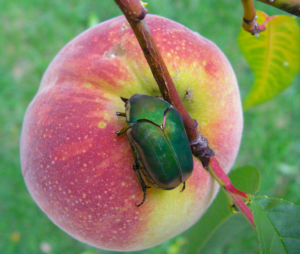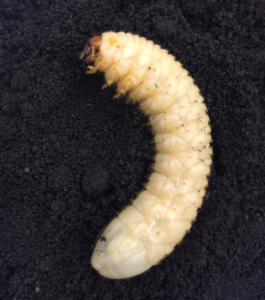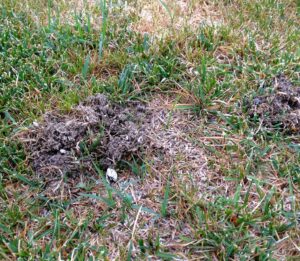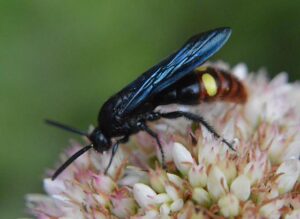Green June beetles Cotinus nitida have been flying in many areas across the Midwest and although they are harmless, their sheer size can be very intimidating to folks who don’t recognize them. These large, attractive, emerald and copper colored beetles (Fig. 1) are one of several species of scarab beetles whose larvae are known as annual white grubs. Of the insects belonging to this group Green June Beetles may be one of the most interesting, not only because of their charisma, but also because of their peculiar biology and behavior.
 |
| Figure 1. Adult Green June beetle feeding on a ripe peach |
Adults typically emerge from the soil during July and heavily infested areas may appear to swarm with activity as the beetle fly about during the day. Adults feed on a variety of ripe fruits and vegetables and may also be attracted to the sap oozing from wounded trees. Emerging females secrete a milky fluid that attracts males to the soil surface for mating as shown in the accompanying video taken by Dr. Cliff Sadof (video 1).
After mating, adult females dig burrows in the soil pushing up small mounds of soil in the process. They seem to prefer high organic matter soils and may be attracted to soils fertilized with compost or manure-based products. Groups of 10-30 eggs may be deposited into a compacted ball of soil, about the size of a golf ball, that the female creates. Several such egg masses may be present in a single burrow composed of several chambers.
After the eggs hatch, larvae (Fig. 2) begin feeding on organic matter by mining through the soil. This activity loosens the soil and may dislodge plant roots, sometime causing damage to turf. As the larvae develop, their burrows may reach 6-12 inches in depth. Soil displaced during this process is deposited at the soil surface creating mounds of soil that may attain 2-3 inches diameter (Fig. 3). On warm nights, especially following rain, larvae may emerge completely from their burrows, crawling considerable distances on their backs! (linked video 2) They have been known to end up on sidewalks and patios, or in garages and swimming pools!
 |
| Figure 2. Green June beetle larva can reach 2 inches in length |
 |
| Figure 3. Mounds of soil formed by burrowing Green June beetle larvae |
Larval burrowing activity may be observed anytime from late summer through early spring as long as soil temperatures are sufficient and larvae usually pupate by mid-June.
The pupal stage lasts about 3 weeks and emerging adults must dig to the surface to start the cycle again.
If green June beetle damage becomes a concern, keep in mind that a large, showy, orange and black colored parasitic wasp, Scolia dubia (Fig. 4), is often able to keep this insect in check. Although the presence of these wasps (which may occur in small swarms) can sometimes alarm homeowners, they are relatively docile and don’t usually sting unless captured or otherwise provoked. In areas where these wasps are active, application of insecticides should be avoided because of the biological control services they provide.
 |
| Figure 4. The Scoliid wasp Scolia dubia parasitizes Green June beetle larvae (Photo by Sharon Moorman) |
Because green June beetle adults are attracted to high organic matter soils, thatch layers should be managed and kept at a minimum. Reduced use of compost topdressings and manure based-fertilizers may reduce the attractiveness of turf areas to egg-laying females.
If insecticides must be used, early instar grubs that are present in late July and early August are the best target because they are relatively easy to control. Any soil insecticide labeled for white grubs will be effective if the application is followed by enough irrigation to move the material into the thatch where the larvae are feeding.
Applications targeting later instar larvae should be left on the surface and not irrigated since these larvae come to the surface to feed at night. However, pre-treatment irrigation can encourage these larger larvae to come to the surface where the insecticide is deposited. Neonicotinoid insecticides are sometimes not effective for controlling late instar green June beetle larvae. Carbaryl (Sevin) or trichlorfon (Dylox) are recommended in such cases.
It should be noted that insecticides applications targeting late instar larvae will often result in larvae dying on the surface. Mortality of large numbers of these larvae may create a problematic stench when conditions are conducive – take my word on this.
by Doug Richmond, Associate Professor and Turfgrass Entomology Extension Specialist